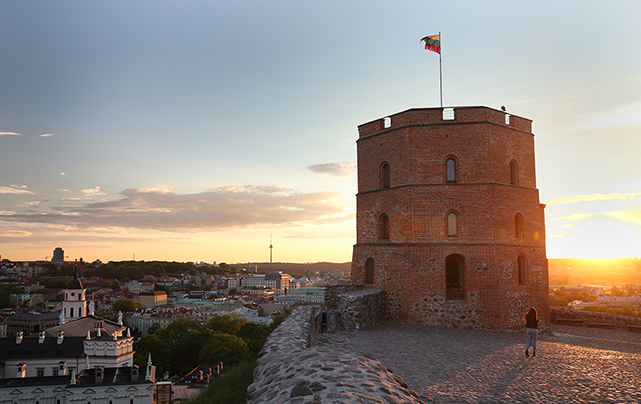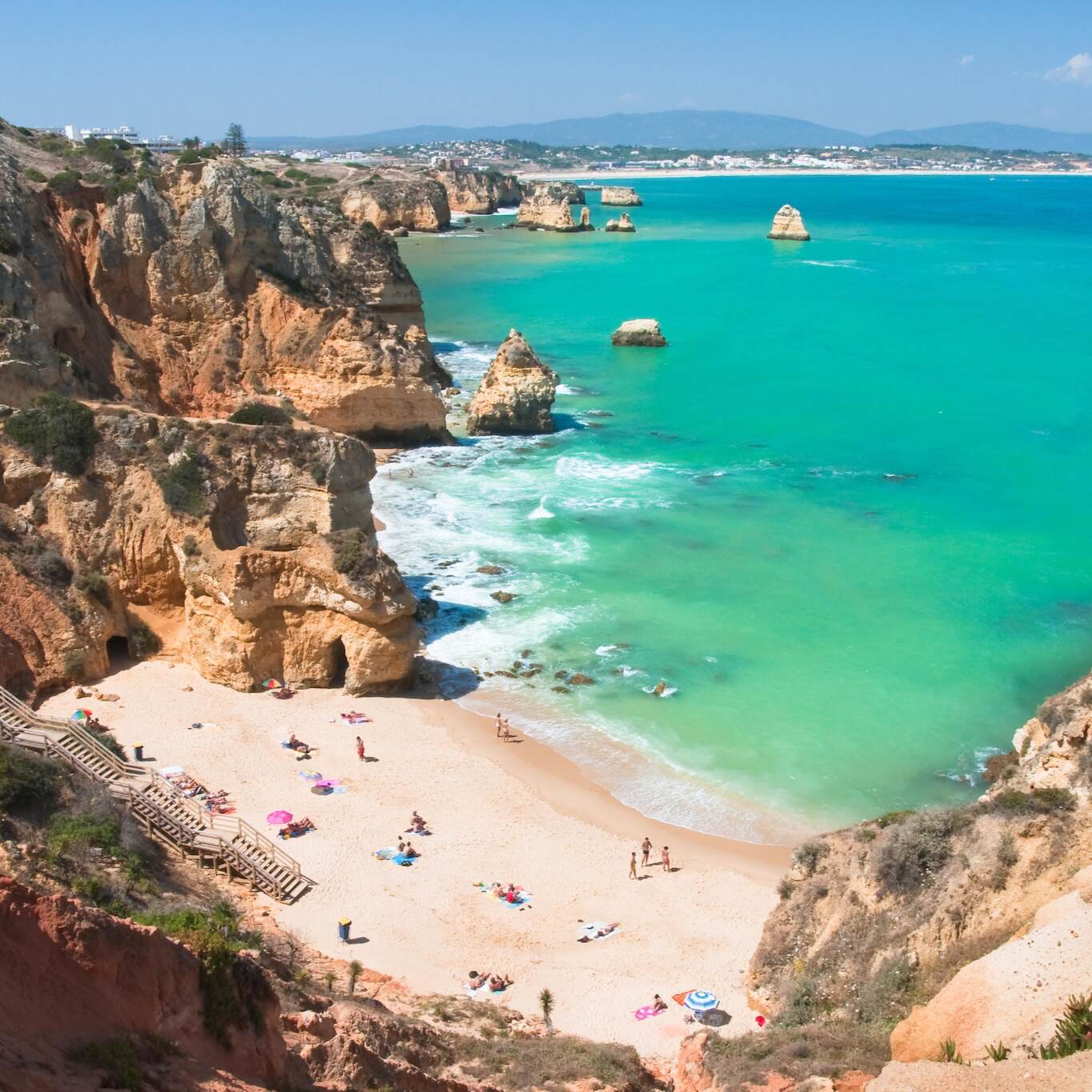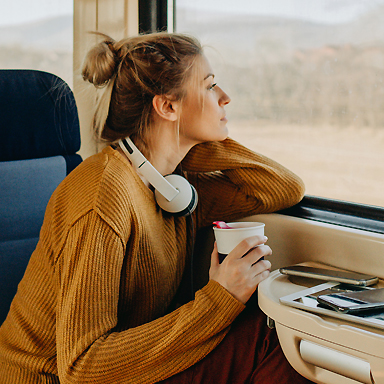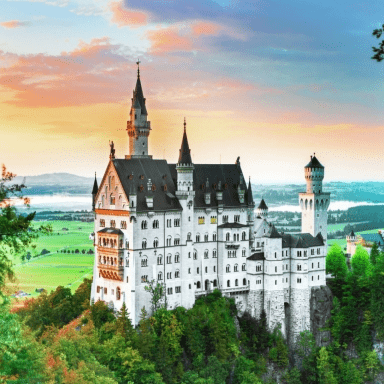
1 week in Lithuania
Lithuania is the southernmost of Europe’s Baltic countries. It may be small, but it’s known for its stunning coastline, isolated wetlands, lush forests, and fascinating cities packed full of history dating back to 1009AD. It also has a convenient rail network that can get you to the country’s best attractions, making it a great destination for Interrailing.
Click here or on the map to view this route in our Trip Planner
This route takes you from the castle of Trakai, to the sand dunes of Curonian Spit, with a little bit of everything else along the way.
Day 1 & 2: Vilnius
Day 3: Trakai
Day 4: Kaunas
Day 5: Klaipeda
Day 6: Nida
Day 7: Siauliai
For this itinerary we recommend:
- Interrail Pass: Lithuania Pass
- Travel days: 5 days within 1 month
Day 1 & 2: Vilnius
Lithuania’s largest city is a modern capital packed full of charm
- Want to trace the city’s historical roots? Head to Gediminas' Tower - though rebuilt in 1933, the tower is the remaining part of Vilnius’ Upper Castle, which dates back to the early 1400s.
- Get to know the city, and the history of Lithuania, by walking to her key monuments and museums. Don’t miss the Museum of Genocide Victims, National Museum of Lithuania, and Three Crosses Monument.
- A trip to Vilnius wouldn't be complete without visiting the Independent Republic of Uzupis, where the streets are lined with art.
How to get there?
Arriving by plane? Vilnius International Airport is located just eight minutes away from the city centre by train.

Day 3: Trakai
Trakai Island Castle
- The greatest draw to the town of Trakai is the 14th century castle on Lake Galve, which is impressive year round.
- While at the castle, check out the Trakai History Museum and possibly catch a piano concert in the gardens.
- Having a Karaite minority, this is the best place in Lithuania to try authentic Kibinai - a meal encased in pastry.
How to get there?
Trakai is a short train journey from Vilnius, reachable in 33 minutes, and buses leave to the nearby castle regularly.

Day 4: Kaunas
Large central Lithuanian city with medieval fortresses
- Kaunas Castle is the main attraction here, and for good reason - it’s one of the country’s first stone castles, built in the 14th century to defend against advancing crusaders.
- Interested in architecture? Head to the Pazaislis Monastery, it’s not only an important historical landmark, but a beautiful example of Italian Baroque architecture in Lithuania.
- If you’re interested in slightly more modern history, visit the Ninth Fort, an important fortress built in the late 19th century.
How to get there?
The train ride between Trakai - Vilnius and Kaunas is just 2 hrs 10 minutes long, and there are departures between the cities throughout the day.

Day 5: Klaipėda
Bustling port city where the river meets the sea
- Klaipeda is another city of art, with many sculptures spread throughout the city, and within its Sculpture Park.
- Want to learn more about Lithuania’s marine life? The Lithuanian Sea Museum is a popular attraction that has a range of sea animals and historical exhibitions.
- Prefer your animals a bit more prehistoric? Then take a trip out to Dino Park, a surreal park with dinosaur exhibits, unusual architecture, and even bathhouses.
- While you're in Klaipėda, don't forget to visit the wooden ship Meridianas. It's the symbol of the city and an impressive sight.
How to get there?
Take the train from Kaunas to Kaišiadorys, then change for the train to Klaipėda. The journey takes around 4 hours and takes you through the heart of the country.

Day 6: Nida
The Curonian Spit - separating lake and sea
- Nida is situated on the Curonian Spit - a nature park that runs along the coastline and across the border into Russian territory.
- The expansive sand dunes are like nothing ever seen before, with shifting sands stretching for 98 kilometers.
- The Curonian Lagoon lies southeast of the city, a great place for nature-lovers to relax and possibly catch sight of a moose.
- The quaint town of Nida offers up many local restaurants to relax in after a day of exploring the nearby natural wonders.
How to get there?
There are buses that leave Klaipėda a few times a day, or take the hourly ferry to Smiltynė on the northern tip of the Curonian Spit.

Day 7: Šiauliai
The gateway to the Hill of Crosses
- There’s one major reason most people visit Šiauliai while in Lithuania, and that is the fascinating and eerie Hill of Crosses, a place of pilgrimage turned symbol of peaceful resistance and offbeat art exhibition.
- Want to take in some fresh Lithuanian air? Rekyva Lake is a popular local escape, and makes for particularly good photos at sunset.
- Prefer to stay indoors? Chaim Frenkel Villa is a massive 20th century palace and museum, famous for its remarkable Japanese etchings.
How to get there?
Trains from Klaipėda to Šiauliai are frequent and the journey quick - there are up to five daily trains between the two and the journey time is one hour.

Ready to travel to Lithuania?
Lithuania is one of the most underrated countries in the Baltics, and given its stunning and diverse natural beauty, long and intriguing history, and easy train connections between major attractions, this is an ideal destination to visit whether you have 3 days or 10.
Even just adding one or two of these cities to your Interrailing itinerary will give you an exciting taste of Lithuania and its culture.
Change of currency
You cannot change the currency once you have a Pass in your cart. Remove the Pass, and then change the currency on the website header.






